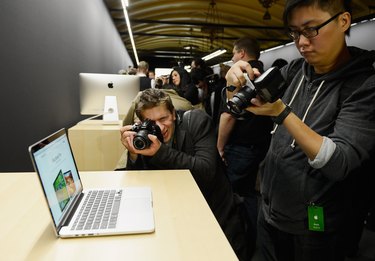
Strange sounds coming from your MacBook Pro's speakers can be caused by damaged or blown speakers, audio settings or a temporary problem that can be resolved by resetting the SMC and PRAM. Troubleshooting a sound problem can indicate whether the sounds are caused by hardware or software, and in some cases, a system update can fix crackling and popping sounds.
Troubleshoot Laptop Speakers
Video of the Day
To figure out how to solve the problem, first determine whether the speakers are the problem or your audio settings are at fault. A problem with the preferences can cause audio issues no matter what you're listening to. Plug in a pair of headphones and listen to anything with sound. If the same problems occur with the headphones, the problem is likely software related. If the sound is clear on the headphones, however, the speakers may be damaged or blown. Blown speakers emit no sounds but distortions, and partially blown speakers may crackle or rattle at high volumes. If you only experience problems as the volume increases, your speakers may be partially blown, and they need to be repaired or replaced.
Video of the Day
Troubleshoot Audio Sources
If you experience audio trouble only while playing certain videos, songs or other files, the files themselves may be corrupted or low quality. Listen to songs or videos that you know work fine and see if the problem persists. Alternatively, if you have a CD or DVD, listen to a song or video from the disc instead of from your hard drive. If the problem remains regardless of where the sound comes from, move on to troubleshooting the sound settings.
Check Audio Preferences
When the speakers are set incorrectly in the operating system's preferences, audio problems are the result. Unplug all external devices from the USB, FireWire and 3.5 mm audio ports and then open System Preferences. Click "Sound," followed by the "Output" tab. Select "Internal Speakers" as the default option. If you don't see any other options, select "Internal Speakers" anyway just to make sure that the option registers. Within these settings, you can test if just one speaker is broken by sliding the Balance slider all the way left or right while audio is playing. If the problem occurs only while the slider is all the way in one direction, it is likely that one speaker is broken and in need of repair.
Install Operating System Updates
According to MacWorld, some Mac OS X users experienced audio issues after the 10.4.10 update, which caused crackling and popping sounds to come from the speakers even though the speakers weren't broken. Update your operating system to the latest version to make sure any audio problems are patched. Even if your laptop's audio problems are not being caused by an update, it's still possible that the most recent update may fix the issue.
Reset PRAM and SMC
Resetting your Parameter Random Access Memory and System Management Controller are troubleshooting steps that can solve problems a simple restart will not, such as failure to recognize devices, sudden shutdowns and kernel panics. To reset the PRAM, shut down your laptop completely. Press the power button to turn it on again and then immediately press and hold the "Command," "Option," "P" and "R" keys until you hear the startup chime sound twice. To reset the SMC, shut down your laptop and confirm the power cable is plugged in. Press and hold the left-side "Shift," "Control" and "Option" keys and the power button for five seconds. Release the keys simultaneously and power on your computer.